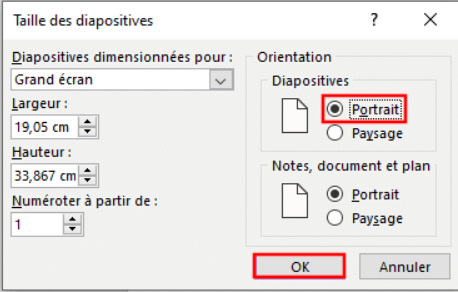How to structure an effective pitch deck to attract investors
Start with the structure that VCs expect most from your pitchdeck
Learn how to switch from 4:3 to 16:9


In this article, we'll explain how to change the orientation of slides in your PowerPoint presentations, from portrait to landscape and vice versa. You'll also learn how to adapt the content of your slides to these orientation changes. Follow these simple steps to master layout techniques.
Before you start creating your PowerPoint presentation, it's important to define the initial orientation of your slides. This will enable you to design the content of your slides more efficiently to suit the space available.
To choose the initial orientation of your presentation, first open PowerPoint and create a new presentation, then select the "Creation" tab from the Ribbon menu. In the "Page Format" area, you'll find two options: Portrait and Landscape. Select the one that best suits your project.

Portrait mode is generally used for documents intended for printing, such as reports or dissertations. It's particularly suitable for presenting large quantities of text, as it offers more vertical space for reading. You may therefore choose to adapt your presentation to A4 format in this case.
Landscape mode is ideal for presentations intended for display on computers, tablets or at events. Most devices have a 16:9 or 16:10 screen ratio. Landscape formats are designed to occupy maximum screen space.
We recommend that you change the orientation before starting production. However, if you need to change the orientation of a document downstream, simply follow the instructions given above. Once the change has been made, a window will prompt you to adapt the content to the new dimensions.

When you change the orientation of your existing presentation, you have two options. Depending on your content, it may be more interesting to apply one method over the other:
Enlarge: Content retains the layout of the previous orientation. This takes it out of the layout.

Guarantee fit: Content adapts to the new format while maintaining the same layout.

In both cases, the layout will have to be reworked. This is why we recommend that you adapt your presentation to the desired dimensions as soon as you have created it. Please note that if you have images embedded in the slide mask, they will be stretched or compressed.
If your Powerpoint presentation is intended for Google Slides, be aware that the dimensions are not the same between these two tools. It may therefore be worth modifying the dimensions to avoid unpleasant surprises such as line indentations or offsets.
When creating your presentation, change the dimensions to those below:
Width: 25.4 cm / Height: 14.292 cm
Your presentation is now ready to be exported to Google Slides.
Switching from portrait to landscape or vice versa in PowerPoint is quick and easy. Simply follow the steps described above to change the orientation of your presentation and adapt the content accordingly. You can download our free landscape PowerPoint template to help you.


























